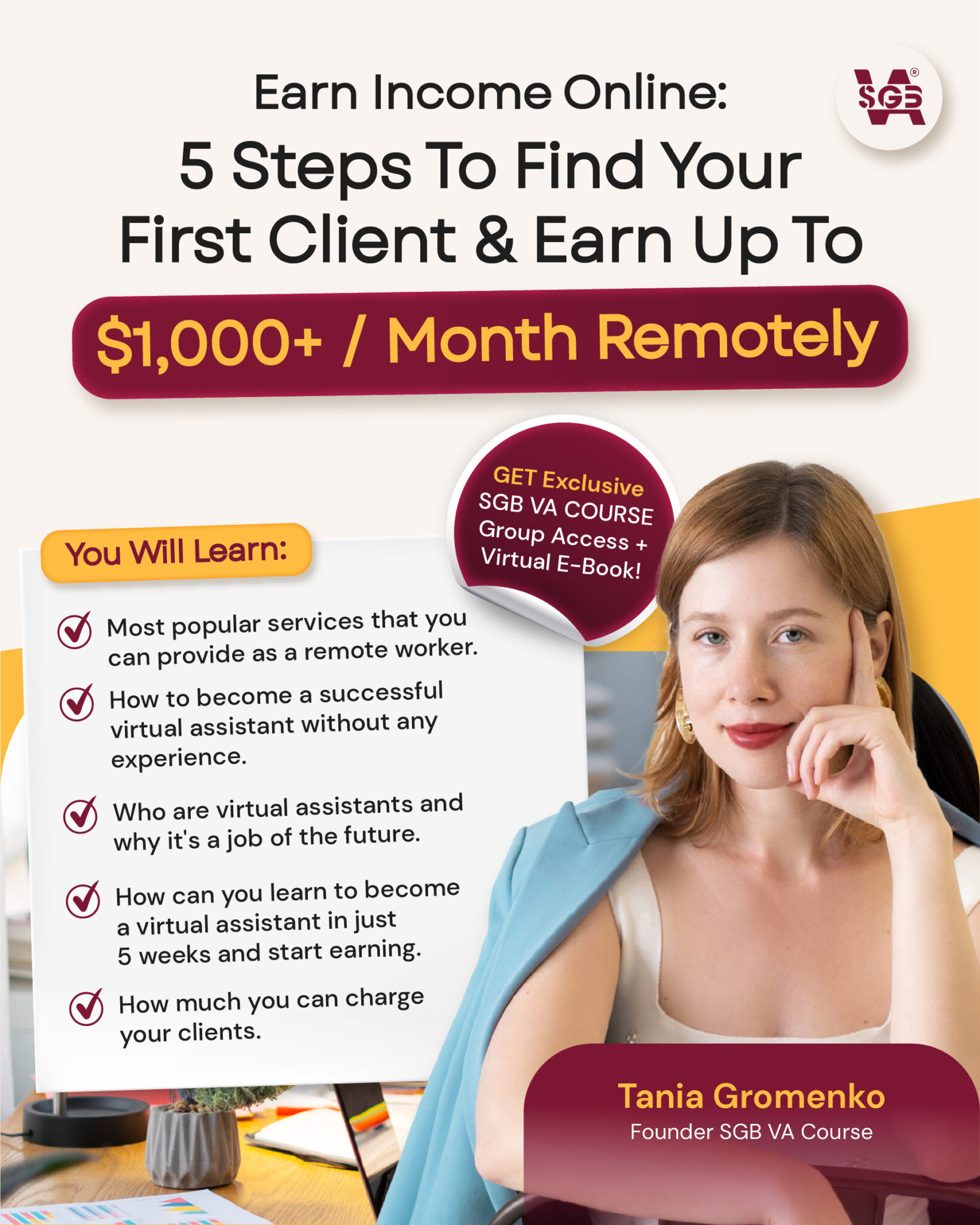Unlock your dream career and do what you love as Virtual Assistant – REGISTER FREE WEBINAR
Have a Question? Contact Us.
Unlock your dream career and do what you love as Virtual Assistant – REGISTER FREE WEBINAR


Oni Lestari
Virtual assistant, copywriter, SEO-expert
Who wouldn’t want to have a good work-life balance, right? If we define work-life balance, most people would probably describe it as having a career with a manageable workload, a great salary, and no need to work overtime. It’s everyone’s dream!
However, many people feel that achieving work-life balance is impossible. This is often because many workplaces operate under the mindset that “a good employee is one who always works overtime” or that “a good employee is always available, even during vacation time.”
But the truth is, you can achieve a healthy work-life balance. First, it’s important to understand what this really means. To help you get started, SGBVA has prepared an article just for you!
Table of Contents
It’s important to know where things started and why to understand it better. So, let’s back to the moment when the concept of work-life balance was born. Work-life balance was started in the United Kingdom in the 80s as an issue in the Women’s Liberation Movement. This movement pushed for women to have the option of flexible work hours and maternity leave.
At that time, people mostly expected women to have a career and still be in charge of the family and home. It relates to women’s role in male-female relationships when taking care of the house. Like cooking, cleaning, taking care of the kids, and many more things. Women felt pulled in many directions because of the responsibility to handle both home tasks and a career. This is when the idea of balancing work and life became important.
Things haven’t changed much. The expectation for women to work and take care of the family and home still seems pretty similar to what we see today. And with the technology changing, achieving work-life balance isn’t just a problem for women but becomes a challenge for everyone.
Technology offers great flexibility and connectivity but also blurs the lines between professional and personal life. The existence of smartphones, email, and remote work tools means that workers are often expected to be available around the clock. It contributes to an ‘always on’ culture.
In today’s competitive job market, many workers also worry about taking time off or saying no to more work. It relates to job insecurity because it makes people think they don’t care about the job. Rising expectations make them end up putting work before their personal life. All of that affects how millennials (1981-1996) and Gen Z (1997-2012) take their action and decisions regarding work-life balance.
Millennials focus more on their lifestyle compared to older generations. But the main difference is that Millenials prefer jobs that match their values. They want to enjoy their work because they don’t see it as separated from their life. For them, life and work mix instead of being separated parts.
And there’s Gen Z, who is just starting to work. It seems they want their jobs to be even more meaningful than millennials do. A study by Dynamic Signal found that they value having a community at work. When they pick a job, they care more about having a balance between work and life, and also about their happiness. Rather than about how much they make or the company’s reputation
So, should you achieve a work-life balance? Some of you might think work-life balance is important, but even if you’re not perfectly balanced, that’s okay. Being imperfect at something doesn’t mean you’re a failure. It simply means you’re human. And if you believe that work-life balance is impossible, you might become a workaholic and continue being overwhelmed.
Because, again, our beliefs and perception of work-life balance affect our mindset and actions about how we manage our time and what we think is possible. The important thing isn’t about whether work-life balance is true or not, but having a clear picture of the life you desire.

Now that we’ve learned about work-life balance, why it matters, and how people see it these days, let’s talk about how to achieve it. One way to do this is by setting clear boundaries.
Boundaries are something that makes us more present, not distracted, and give all the attention to what we care about. Without boundaries, work keeps expanding because there’s no stop time.
When our focus is split between work and our personal life. We are unable to devote ourselves to either fully. Imagine when we’re having dinner with family or friends while checking phones constantly, worried about the project and other tasks. We might think it’s a productive way to do two things at the same time. But actually, we’re not paying attention to either because we’re not being present.
After some time, it might seem like we’re always working and our work-life balance isn’t right even though we’re not getting more work done. It’s like we’re always working but there’s always more work left. This can be confusing and frustrating. So, here’s the step to make your boundaries more clear:
Don’t let someone define your boundaries, do it yourself. Because when you let someone else drive you, don’t be surprised if you don’t like the direction your time is taking. To do it, you need to make a visual of what condition you’re okay and not okay with.
For example, if you’re a mom with a job and a family to take care of, you can ask yourself:
‘Am I okay doing work after my work hours are done?’
‘Am I okay with canceling plans to work for an important client?’
‘Am I okay with missing dinner and bedtime stories with my kids, to talk on the phone with my boss?’
Then, put them into a decision and write it down to make them more real. Because it will be challenging to stick to boundaries when you’re not deciding and defining it. After that, communicate with your boss, clients, or team about it. And use automation apps if needed to make your workflow simpler and easier.
After-work routine is a few simple steps that help you relax and switch off from work for the rest of your evening. For example, after-work routine is when you move from your workspace if you work from home. It’s like a ritual to end work and contributes as a ‘commute’ to separate between the workday and family time. Or, when you take off your outside shoes and put on slippers when you arrive home. It’s like a physical routine, so your mindset can shift from work mode to personal life mode.
Or if you’re a working mom, your after-work routine might include parking at daycare, opening up your email, and responding to each outstanding email with something like:
‘Hey there, I got your message, I’ll send you that first thing tomorrow’.
‘Hey there, I’d love to be your partner, I’ll send more information on how we can get started first thing tomorrow’.
Then, shift your mindset to time with your kids or family.
If you find yourself in a situation where the previous strategies don’t seem feasible for you, take a moment to consider the following scenario:
Perhaps you find yourself in a job that makes you feel like: ‘My boss wants me to always be available, even at night or on weekends. If I don’t reply quickly, I might lose my job. I work in an industry where I have to be available all the time.’
Before jumping to a conclusion, ask yourself: ‘Is my boss genuinely expecting me to be available 24/7, or am I hesitant to set up boundaries and communicate my needs?’. After you slowly think about that, this question may reveal that the pressure to always be available comes from your expectations for yourself.
However, if you realize that your job demands are genuinely unreasonable, you can take some time to figure out exactly what kind of life you want.
Do you prefer working from home?
Do you want a flexible job that doesn’t require you to work 9-5?
What are the most important things to you, is it your time with kids and family?
If you’re feeling stuck in your current job or industry, maybe it’s time to explore new opportunities. A difficult boss, a toxic work environment, or a job that no longer fits your lifestyle could be holding you back. Switching careers to something more flexible, like becoming a virtual assistant, might be the solution you need—especially if you’re looking for more work-life balance.
Virtual assistants help businesses with tasks like administration, management, and digital marketing from a remote location. They play a key role in supporting companies while enjoying the freedom of remote work.
Join SGBVA’s FREE Webinar led by our mentor, Tania Gromenko, a former virtual assistant turned successful entrepreneur. In 2021, she increased her income 20-fold, and in this webinar, she’ll reveal how to:
As a bonus, you’ll also receive a free e-book titled “FAQ About Virtual Assistants” and access to our exclusive SGBVA Telegram community, where you can gain valuable tips and insights.
Click here to register for the free webinar today!
© 2024 All rights reserved | Gromenko & Partners Pte.Ltd.

By clicking the button, you agree to subscribe to SGBVA’s webinar content and newsletters.


By clicking the button, you agree to subscribe to SGBVA’s webinar content and newsletters.